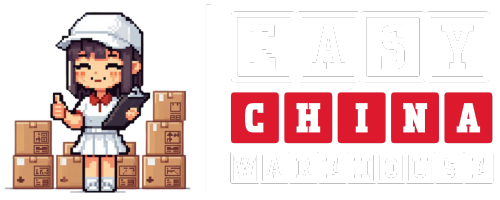Login
How To Find A Cost-Effective China Warehouse And What Are Their Storage Fee?

- Why e-commerce business may need a warehouse in China
- How to find a Cost-Effective China Warehouse
- How much do warehouses cost in China?
- Do Chinese warehouses use modern and innovative technology?
- Do Chinese warehouses take responsibility if goods get damaged in the warehouse?
- What is Standard China Warehouse Storage fee
- What is Standard Loading fee?
- What is Standard Labeling fee?
China warehouses play a significant role in global supply chains and e-commerce operations due to China’s role as a major manufacturing hub and exporter of goods.
If you are a business owner in search of reliable storage space then China warehouse is the best way to store your goods.
China Warehouses Serve Several Purposes:
Storage and Distribution
They provide a place for manufacturers and suppliers to store their products before they are shipped to customers, retailers, or other distribution centers around the world.
Fulfillment Services
Many e-commerce businesses and international sellers use China Warehouses as part of their order fulfillment process. This involves storing inventory in these warehouses and having them handle the packaging, labeling, and shipping of products directly to customers, saving time and shipping costs.
Strategic Location
China’s central location in Asia makes it a convenient distribution point for products to be shipped to various parts of the world, taking advantage of efficient logistics networks.
Customs and Import/Export
Warehouses in China can also assist with customs clearance and compliance with import and export regulations, making it easier for businesses to navigate the complexities of international trade.
Cost Savings
By storing goods in China Warehouses, businesses can often benefit from reduced storage costs compared to warehouses in other countries, contributing to overall cost savings in the supply chain.
Inventory Management
Warehouses in China can provide inventory tracking and management services, helping businesses keep track of their stock levels and optimize their inventory.
There are many warehouses in China. So, you can rent a Chinese 3pl warehouse that best suits your needs.
You can find the best warehouses in the following places:
• Guangzhou
• Shenzhen
• Shanghai
• Yiwu
• Xiamen
• Ningbo
How To Find a Cost-Effective China Warehouse?
Finding a cost-effective China Warehouse involves careful research and consideration of various factors to ensure that the chosen facility meets your needs and budget.
Here’s a step-by-step guide to help you find the right warehouse:
-
- Step 1. Define Your Requirements
Clearly outline your warehousing needs, such as storage capacity, location preferences, distribution capabilities, and any additional services you require (e.g., order fulfillment, inventory management).
- Step 1. Define Your Requirements
-
- Step 2. Research Warehousing Options
Start by researching different warehousing options available in China. Use online platforms, industry directories, and trade associations to identify potential warehouse providers.
- Step 2. Research Warehousing Options
-
- Step 3. Compare Costs
Contact multiple warehouse providers and request detailed cost breakdowns. Compare the pricing structures, including storage fees, handling charges, order fulfillment costs, and any other applicable fees.
- Step 3. Compare Costs
-
- Step 4. Location Consideration
Choose a location that strategically serves your target markets. Consider proximity to major transportation hubs, ports, and logistical networks for efficient distribution.
- Step 4. Location Consideration
-
- Step 5. Evaluate Services Offered
Assess the range of services provided by each warehouse. Look for services that align with your requirements, such as order processing, packaging, labeling, and customs clearance.
- Step 5. Evaluate Services Offered
-
- Step 6. Check Facility Conditions
If possible, visit the warehouses or request photos to evaluate their physical conditions. Ensure they meet safety standards, have proper infrastructure, and can accommodate your inventory appropriately.
- Step 6. Check Facility Conditions
-
- Step 7. Quality of Service
Read reviews and testimonials from other businesses that have used the warehouse’s services. This can give you insights into the reliability, efficiency, and customer service quality of the provider.
- Step 7. Quality of Service
-
- Step 8. Negotiate Terms
Once you’ve identified a few potential options, negotiate the terms of the contract. Discuss pricing, service agreements, flexibility, and any customization you might need.
- Step 8. Negotiate Terms
-
- Step 9. Understand Contract Terms
Carefully review the contract terms, including cancellation policies, insurance coverage, and any potential hidden costs. Ensure that you understand and agree to all terms before finalizing the agreement.
- Step 9. Understand Contract Terms
-
- Step 10. Visit the Warehouse (if possible)
If feasible, visit the shortlisted warehouses in person. This will give you a firsthand experience of the facilities, staff, and operations.
- Step 10. Visit the Warehouse (if possible)
-
- Step 11. Consider Scalability
Think about your future growth plans. Choose a warehouse that can accommodate your expanding needs without significant disruption.
- Step 11. Consider Scalability
-
- Step 12. Seek Professional Advice
If you’re unfamiliar with the process, consider consulting with logistics or supply chain experts who can provide guidance on selecting a suitable and cost-effective China Warehouse.
- Step 12. Seek Professional Advice
- Step 13. Start with a Trial Period
If possible, begin with a smaller commitment or trial period to assess the warehouse’s performance before making a long-term commitment.
Remember that the cheapest option may not always be the best choice, as quality of service, reliability, and location also play crucial roles in your overall supply chain efficiency. It’s essential to strike a balance between cost-effectiveness and meeting your business requirements.
Read about main mistakes while choosing a China warehouse.

How Much Do Warehouses Cost In China?
The cost of warehouses in China can vary widely depending on factors such as location, size, facilities, services offered, and the specific city or region within China.
- Location: Warehouses located in major cities or close to transportation hubs and ports tend to be more expensive due to their strategic advantages for distribution. Warehouses in less urban areas may be more affordable.
- Size: Warehouse costs are often calculated based on the square footage (or square meters) of space you need. Larger warehouses will generally cost more than smaller ones.
- Type of Warehouse: The type of warehouse can also influence costs. For example, a specialized temperature-controlled warehouse or a modern automated warehouse may have higher costs compared to a basic storage facility.
- Services: If the warehouse offers additional services such as order fulfillment, inventory management, packaging, and distribution, the costs will likely be higher.
- Lease Length: Longer lease commitments might result in more favorable rates compared to short-term leases.
- Market Conditions: The real estate market conditions in the specific region can affect warehouse rental prices. Supply and demand dynamics play a role in determining rental rates.
- Customization: If you require customized features or layout adjustments to suit your business needs, this could impact the overall cost.
As a rough estimate, in major cities like Shanghai, Beijing, or Guangzhou, warehouse rental costs can range from around $6 to $9 or more per square meter per month, depending on the factors mentioned above.
Do Chinese Warehouses Use Modern And Innovative Technology?
Yes, many Chinese warehouses have adopted modern and innovative technologies to enhance their operations, improve efficiency, and meet the demands of an increasingly complex supply chain landscape.
China has been a hub for manufacturing, e-commerce, and international trade, driving the adoption of advanced technologies in its warehouses.
Here are some examples of the technologies commonly used in Chinese warehouses:
Automation and Robotics
Chinese warehouses have increasingly integrated automation and robotics for tasks such as inventory picking, sorting, and packaging. Automated guided vehicles (AGVs), robotic arms, and conveyor systems are used to streamline processes and reduce manual labor.
Warehouse Management Systems (WMS)
WMS software is used to optimize warehouse operations by managing inventory, orders, and workflows. These systems provide real-time visibility, improve inventory accuracy, and enhance order fulfillment.
Internet of Things (IoT)
IoT devices are employed to monitor and track inventory in real time. Sensors, RFID tags, and IoT-enabled devices help improve inventory accuracy and enable predictive maintenance.
Artificial Intelligence (AI)
AI is used to optimize inventory forecasting, demand planning, and supply chain analytics. Machine learning algorithms help warehouses make data-driven decisions and optimize their operations.
Big Data Analytics
Chinese warehouses leverage big data to analyze historical and real-time data, allowing them to identify trends, optimize routes, and improve overall operational efficiency.
Augmented Reality (AR) and Virtual Reality (VR)
AR and VR technologies are used for training warehouse staff, aiding in order picking, and facilitating maintenance tasks. They enhance accuracy and reduce training time.
Smart Warehousing
Warehouses in China use smart technologies to monitor conditions such as temperature, humidity, and storage conditions. This is particularly important for goods that require specific environmental conditions, such as perishable items.
Cloud Computing
Cloud-based systems enable seamless data sharing, collaboration, and access to information from various locations. This is crucial for international supply chains that involve multiple parties.
Drones
In certain cases, drones are used for inventory management and order fulfillment, especially in large warehouse complexes or outdoor storage areas.
Voice Technology
Voice-guided systems assist warehouse staff in picking and packing orders, reducing errors and increasing efficiency.
Blockchain
Some Chinese warehouses explore blockchain technology for enhancing supply chain transparency, traceability, and authenticity verification.
China’s commitment to technological advancement and its role as a global manufacturing and e-commerce leader have driven the adoption of these innovative solutions.

Do Chinese Warehouses Take Responsibility If Goods Get Damaged In The Warehouse?
It’s important to thoroughly review the terms of your agreement with the warehouse provider and understand their policies related to liability and damages. Here are some key points to consider:
Contractual Agreement
The warehouse agreement you sign with the warehouse provider will outline the terms and conditions related to liability and damages. It’s crucial to review this agreement carefully before storing your goods in the warehouse.
Liability Limits
Warehouses may include clauses that limit their liability for certain types of damages or losses. These limits might be based on factors such as the value of the stored goods or the nature of the damage.
Insurance
Some warehouses may offer insurance options to cover potential damages to goods while they are stored in the facility. It’s important to inquire about insurance coverage and understand what it covers and what it doesn’t.
Inspection and Documentation
Prior to storing your goods in the warehouse, it’s advisable to conduct a thorough inspection of the items and document their condition. This can serve as evidence in case of disputes regarding damage that occurred within the warehouse.
Notification
If you discover damage to your goods while they are in the warehouse, promptly notify the warehouse provider and follow their procedures for reporting and documenting the damage.
Force Majeure
Some agreements might include clauses related to force majeure events, which are unforeseeable circumstances that can affect the warehouse’s ability to protect goods from damage. These events might include natural disasters, fires, and other external factors.
Legal Framework
The legal framework surrounding liability for goods stored in warehouses can vary between countries and regions. Local regulations and industry practices can influence how liability is determined.
Third-Party Liability
If a third party, such as a logistics company, is responsible for the transportation of goods to and from the warehouse, their liability for damages during transportation should also be considered.
To ensure that you understand the extent of the warehouse’s responsibility for goods damaged while in their custody, we recommend to consult with legal experts familiar with the specific regulations and practices in China.
Additionally, discussing these matters openly with the warehouse provider and clarifying their policies and procedures can help you make an informed decision about storing your goods in their facility.

What Is Standard China Warehouse Storage Fee?
The standard storage fee for a warehouse in China can vary widely based on several factors, including the location, size of the warehouse, type of goods stored, services provided, and the specific warehouse provider.
In major cities like Shanghai, Beijing, or Guangzhou, storage fees for a basic warehouse can range from approximately $8 to $20 per square meter per month.
It’s also worth noting that some warehouses might have different pricing structures, such as charging based on pallet positions or other metrics. Additionally, if you require value-added services like order fulfillment, packaging, or inventory management, these services could incur additional costs.
What Is Standard China Warehouse Loading Fee?
The loading fee typically refers to the cost associated with the handling, loading, and unloading of goods within the warehouse. This can include tasks such as moving goods from the storage area to loading docks, preparing them for transportation, and coordinating with carriers.
The loading fee might be calculated based on different metrics, such as the number of pallets, weight of goods, or volume of goods being loaded/unloaded.
For a rough estimate, loading fees in China can range from around $0.10 to $0.50 or more per kilogram of goods loaded or unloaded.
What is Standard China Warehouse Labeling fee?
The labeling fee for a warehouse in China refers to the cost associated with labeling or tagging products or inventory items with relevant information, such as barcodes, SKUs (stock-keeping units), product names, and other identifying details. Proper labeling is crucial for accurate inventory management, order processing, and distribution.
Labeling fees can be calculated in different ways, such as per unit, per label, or as a set fee based on the quantity of goods or the complexity of the labeling process.
For a rough estimate, labeling fees in China might range from approximately $0.10 to $1 or more per unit, depending on factors such as the type of label, information to be included, and the efficiency of the labeling process.
When considering any fees related to warehouse for ecommerce, we advise to request quotes from multiple providers and compare their offerings to find the best balance between cost and quality for your business needs.
Easy China Warehouse strategically situates itself in a prime logistics supply chain region in Guangdong China, also known as the bay area. Given the region’s robust infrastructure, including well-connected transportation networks and modern port facilities, allows Easy China Warehouse to optimize supply chain operations, minimizing transit times and reducing costs.
Easy China Warehouse offers 3500 square meters of storage space for its customers in China and can meet any storage needs. It boasts a modern facility with all the newest fire and theft protection systems to keep its customers inventory safe.
Easy China Warehouse also provides the most flexible storage solutions for its customers by only charging for its storage per CBM by the day. See our prices by downloading this file.
Connect with Easy China Warehouse today to see how our storage and fulfillment solutions can help your business grow.
